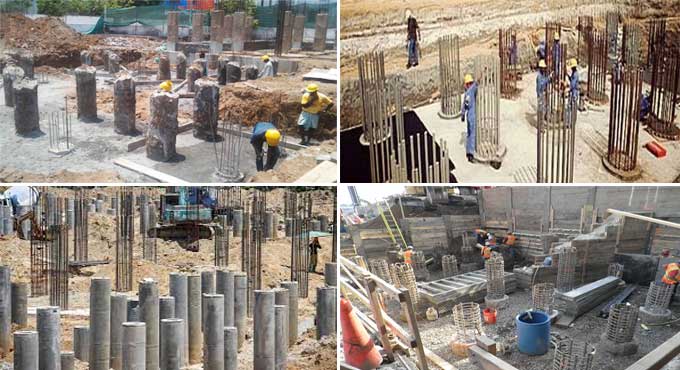NEWS | SOFTWARE | SHEET
Different types of Pile Foundation and their use in Construction
These types of foundations are primarily circular and dug into the ground. Rather than sitting on top of the ground, shallow foundations transfer vertical loads directly to the soil.
When soil capacity represents as allowable bearing capacity, the geotechnical design will be acceptable if the applied pressure is below the allowable bearing pressure.
Types of Pile Foundation
A. Micro Piles
Low-rise building construction uses micro piles quite often. A deep foundation is necessary when the ground is weak. The structural load cannot support by the ground.
B. Precast Piles
Construction of these piles occurs when applied loads are lower than those of bored piles.
Moreover, precast piles are inserted or terminated rather than driven into the rock. Although the ends are bearings, these piles are mostly friction piles.
C. Sheet Piles
Sheet piles are also classified as pile foundations, even though they are mainly used to support structures indirectly. In the case of sheet piles, they are used to support the soil surrounding a structure and act as a permanent structure. Determining whether the construction should be removed or considered permanent depends on the structure's nature and the ground's condition.
D. Bored Piles
According to the applied load, single piles or group piles are constructed for bored piles. For example, shear walls, lift cores, and shear cores are supported by group piles.
E. Screw Piles
Screw piles can be used to construct building connections or other constructions, such as bridges. Types of screws are determined by the construction type. Screw piles can also be classified according to their type.
F. Timber Piles
Construction of expansion and construction of new buildings is characterized by timber piling. Timber pilings were used for the construction of buildings and bridges.
The use of timber piles is limited to areas where heavy machinery can't be brought to. Neither modern nor ancient constructions use inferior technology.
The advantages of timber piles include their durability, affordability, and sustainability. The best kind of timber to use is one that has good durability properties. The skin friction and end bearing must carry the load.
How to select Pile Foundation
- The use of a reamed pile foundation with a grade beam and pile cap or a bored cast in situ pile foundation with pile cap may be appropriate for weakly bearing soils such as soft clay, medium clay, or any clay.
- Reamed piles with pile caps connected with grade beams are best for clay soils with 3 and 4 floors.
- When the stratum is hard at 10 m, End bearing or bore piles may use. They are best suited to multi-story buildings.
- Typical under-reamed piles have a depth of 3.5m to 4.50m with pile caps. When the load is 2000KN to 3000KN, bored cast piles of 6.0m to 20.0m use pile caps.
To get more clear ideas, go through the following exclusive construction video tutorial.
Lecturer: Civil Engineering
Key Reasons supporting the Structure Using Pile Foundation
- Due to their low bearing capacity, shallow foundations cannot carry vertical loads applied to them.
- It occurs when the soil contains a thin layer of peat.
- The foundation must be able to carry the tensile forces. Anchoring the rock with tensile forces is possible.
- The foundation carries lateral loads. The inclined pile will support both tensile and compression forces.
- The soil bearing capacity of tall buildings can't handle high vertical loads, especially when the vertical loads are high. Stacks are needed.
Recommended Articles:
Concreting of Pile Foundations – Utility and Standard of Concrete for Piles


